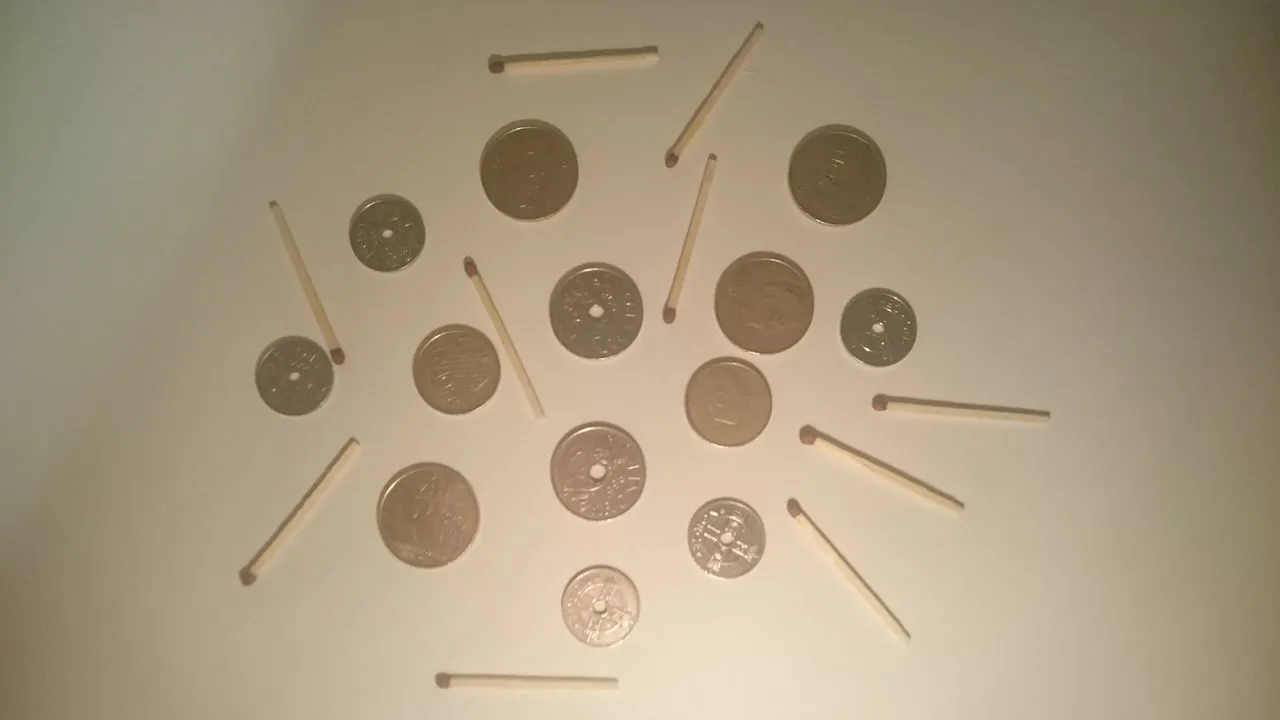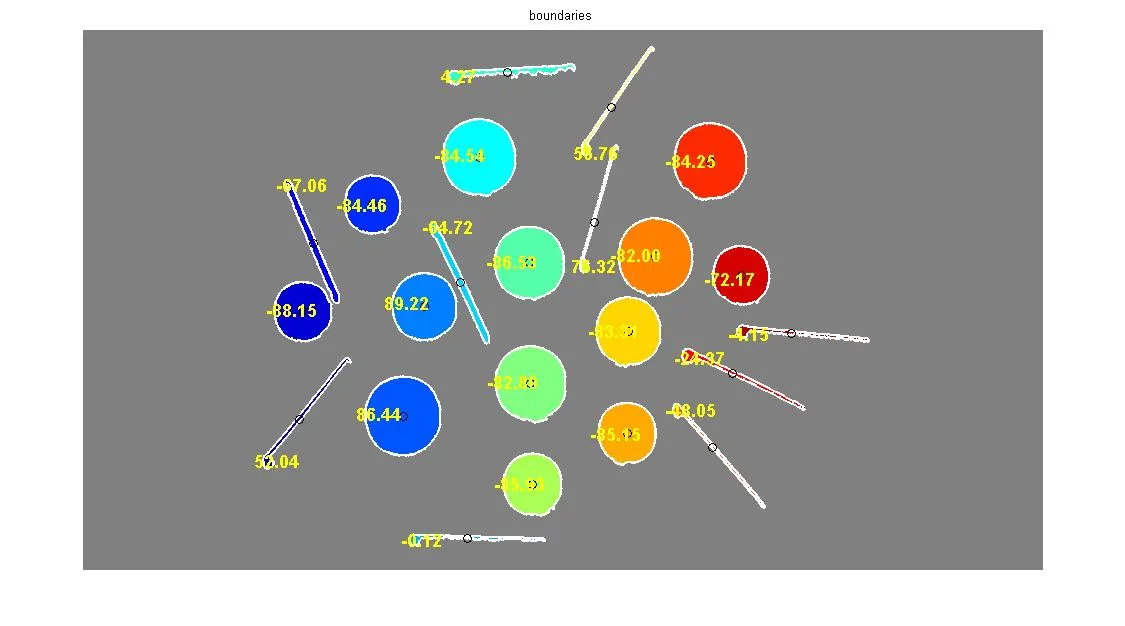我正在尝试使用MATLAB识别图片中每个价值的火柴和硬币数量。这是原始图片,包含5个小银币、2个小金币、2个大银币和4个大金币。
 输出结果如下:
输出结果如下:
 以下是代码:
以下是代码:
 输出结果如下:
输出结果如下:
 以下是代码:
以下是代码:close all;
img = (imread('C:\Users\Torstein\Jottacloud\Skole\Visu\Prosjekt\sample_images\sample2.jpg'));
img_gray = rgb2gray(img);
% Filter image for easier edge detection
m = 12;
n = 12;
img_filter = imfilter(img_gray, fspecial('average', [m n]));
%figure, imshow(f), title('f')
% Edge detection
[~, threshold] = edge(img_filter, 'canny');
fudgeFactor = 1.5;
img_edge = edge(img_filter, 'canny', threshold * fudgeFactor);
figure, imshow(img_edge), title('edge detection')
% Dilate image to make the coin edges complete without holes
se_disk = strel('disk',4);
se_line1 = strel('line',3,100);
se_line2 = strel('line',3,100);
img_dilated = imdilate(img_edge, se_disk);
img_dilated = imdilate(img_dilated, [se_line1 se_line2]);
figure, imshow(img_dilated), title('dilate')
% Remove small objects (noise) and fill complete objects
img_clearborder = imclearborder(img_dilated, 4);
%figure, imshow(BWclear), title('cleared border image');
img_fill = imfill(img_clearborder, 'holes');
figure, imshow(img_fill), title('fill holes')
% Erode image to make a clear cut between objects
se_diamond = strel('diamond',2);
img_erode = imerode(img_fill,se_diamond);
for k=1:3
img_erode = imerode(img_erode,se_diamond);
end
img_nosmall = bwareaopen(img_erode,300);
figure, imshow(img_nosmall), title('erode')
[B, L] = bwboundaries(img_nosmall);
figure, imshow(label2rgb(L, @jet, [.5 .5 .5])), title('boundaries')
hold on
for k = 1:length(B)
boundary = B{k};
plot(boundary(:,2), boundary(:,1), 'w', 'LineWidth', 2)
end
stats = regionprops(L,img(:,:,1),...
'Area','Centroid','Orientation','EquivDiameter','MeanIntensity');
threshold = 0.80; % For differentiating coins from matches based on an objects circularity
coinCentroids = [];
coinIntensities = [];
matchCentroids = [];
matchAngles = [];
coinRatios = [];
for k = 1:length(B)
boundary = B{k};
delta_sq = diff(boundary).^2;
perimeter = sum(sqrt(sum(delta_sq,2)));
area = stats(k).Area;
metric = 4*pi*area/perimeter^2;
metric_string = sprintf('%2.2f',metric);
angle_string = sprintf('%2.2f',stats(k).Orientation);
centroid = stats(k).Centroid;
if metric > threshold
% Object is round, therefore a coin
coinCentroids = [coinCentroids; centroid];
coinIntensities = [coinIntensities; stats(k).MeanIntensity];
coinRatios = [coinRatios; stats(k).EquivDiameter/area];
else
% Object is a match
angle = stats(k).Orientation;
matchCentroids = [matchCentroids; centroid];
matchAngles = [matchAngles; angle];
end
plot(centroid(1),centroid(2),'ko');
% text(boundary(1,2)-35,boundary(1,1)+13,angle_string,'Color','y',...
% 'FontSize',14,'FontWeight','bold');
end
如您所见,我已经确定了哪些物品是硬币,哪些是火柴。
但是,我很难确定硬币的价值。
例如,硬币的面积/直径给出以下结果。仅根据这些数据,我无法清晰地区分不同类型的硬币; 数字太接近了。
0.0041 0.0042 0.0043 0.0043 0.0044 0.0045 0.0048 0.0048 0.0053 0.0054 0.0055 0.0055 0.0056
我试着从每个硬币的起始图片中获取平均颜色强度,但这并没有帮助我区分银色硬币和金色硬币。
从红色通道得到的平均强度并不能告诉我们有6个金色硬币和6个银色硬币。
105.0104
105.4408
107.9070
112.4762
116.3412
127.3481
132.1418
137.9697
149.6601
159.2506
167.6910
181.1673
215.0395
问题:我如何确定不同的硬币价值?
(在这里询问如何分离两个重叠的对象:使用MATLAB分离图像中的两个重叠圆形)
谢谢
regionprops函数,应该会给您一个很好的分离效果。 - Shairegionprops一起计算出圆度,然后使用类似于0.5的阈值提取出圆形对象。该帖子还提示要谨慎使用离心率,如果您决定使用它。 - rayryeng